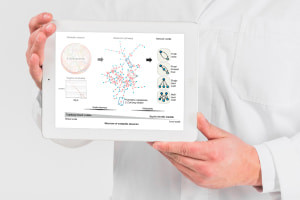Biologists are faced with two fundamental questions about living systems. First, if every molecule in a cell is replaced over time, it is still the same cell? Secondly, if every cell in an organism is replaced over time, is it still the same organism? High-throughput technologies have advanced significantly and we have an understanding of the ‘wiring diagrams’ of living systems. In course, you will learn about the energy requirements of living cells in biosynthesis, transport of nutrients, and cell maintenance. Discover the three cardinal points of bioenergetics, which highlight the importance of ATP (adenosine triphosphate) in biofuel synthesis, cell maintenance, microbial motility and re-synthesis of macromolecules. Study the process of ATP formation from the electron transport chain (also known as phosphorylation), and the systems by which the cells overcome energy shortage under anaerobic conditions. Likewise, you examine the law of mass action, as well as the induction and repression models of gene regulation. Learn to distinguish between one-dimensional and two-dimensional annotations of genome sequences: the difference will help you identify the open reading frames (ORFs), gene product functions, and the mathematical models (stoichiometric matrix) for representing the component interactions. Did you know that measuring the metabolic fluxes (i.e. the phenotype of the cell) is a systems biology problem? Learn how metabolic engineers adopt systems engineering methodologies for identifying the evolution of biological functions, and emergent properties of cells and communities from genetic sequences.
Next, you will discover the ‘sense of purpose’ of every microbial cell, as well as the functional states and properties of biological networks. Consider that you have many options for printing the documents you have saved in your computer system. Similar to the equivalent options in printing a document, the numerous ways through which a cell can perform its various functions will be outlined. You compare and contrast the two types of biological network models to discover the strength and weaknesses of both approaches. The module on transcriptional regulatory networks will cover the three fundamental data types, the associated problems with each regulatory system, and their significance in cell behaviour. Study the network reconstruction process, and the effects of intermediary metabolism, which elaborates their regulatory structures. Additionally, you will learn novel methods that will help you to properly conceptualize the four vital levels of network functions. The module on genome-scale metabolic model reconstruction examines genome annotation, biochemical and physiological data identification procedures, and quantitative analysis. Familiarize yourself with the steps for genome annotation, and see the numerous databases where the network data can be curated and expanded.
Finally, the mathematical representation of reconstructed networks answers key questions like, ‘What are the characteristics of the frameworks for the chemical reactions in remodelled networks?’ and ‘What does the mathematical formulation tell about the state of the biological and chemical networks?’. Discern the basic features of the stoichiometric matrix and its interconnectedness with the stoichiometric coefficients. You will also learn about network boundaries, network maps, and how to use multi-omics data via biotransformation to generate information from the database. See how you can differentiate determined and under-determined systems. Then, the constraints which affect all living cells, and the concepts of the bounded space of the stoichiometric matrix, as well as subject areas in thermodynamically infeasible cycles will be discussed. Furthermore, consider the four optimization methods for constraint-based reconstruction and analysis (COBRA) of metabolic networks. The systems for flux coupling finder, as well as comprehensive dynamic flux balance analysis (DFBA) and gene deletion algorithm models are explained. The complex and highly technical aspects of this course have been expertly simplified to make it more exciting and rewarding for you when you take on the challenge. Enrol in this course today!
What You Will Learn In This Free Course
View All Learning Outcomes View Less All Alison courses are free to enrol, study, and complete. To successfully complete this Certificate course and become an Alison Graduate, you need to achieve 80% or higher in each course assessment.
Once you have completed this Certificate course, you have the option to acquire an official Certificate, which is a great way to share your achievement with the world.
Your Alison certificate is:
- Ideal for sharing with potential employers.
- Great for your CV, professional social media profiles, and job applications.
- An indication of your commitment to continuously learn, upskill, and achieve high results.
- An incentive for you to continue empowering yourself through lifelong learning.
Alison offers 2 types of Certificate for completed Certificate courses:
- Digital Certificate: a downloadable Certificate in PDF format immediately available to you when you complete your purchase.
- Physical Certificate: a physical version of your officially branded and security-marked Certificate
All Certificate are available to purchase through the Alison Shop. For more information on purchasing Alison Certificate, please visit our FAQs. If you decide not to purchase your Alison Certificate, you can still demonstrate your achievement by sharing your Learner Record or Learner Achievement Verification, both of which are accessible from your Account Settings.











 Avg. Hours
Avg. Hours  Contains Video
Contains Video  CPD Accredited
CPD Accredited 
 Total XP:
Total XP: 
 Knowledge & Skills You Will Learn
Knowledge & Skills You Will Learn 







